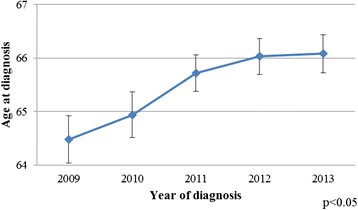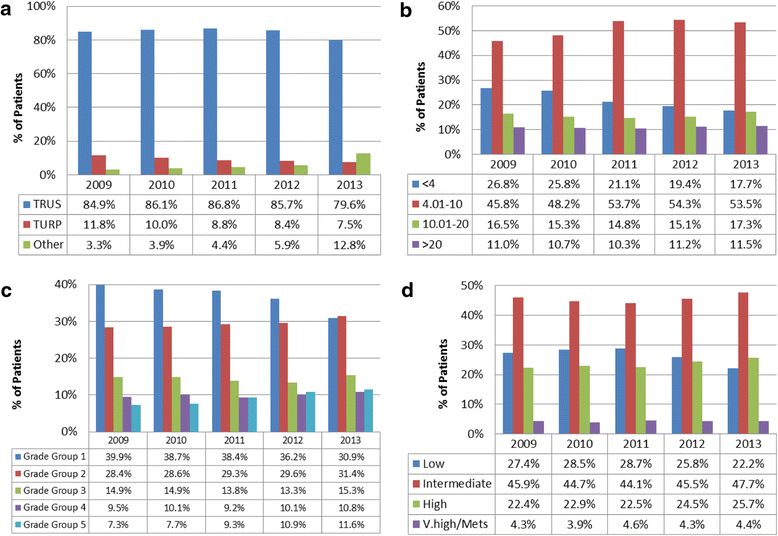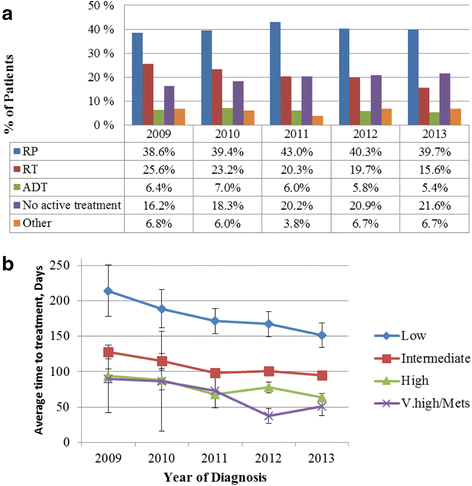A retrospective analysis of Victorian and South Australian clinical registries for prostate cancer: trends in clinical presentation and management of the disease
- PMID: 27496055
- PMCID: PMC4974765
- DOI: 10.1186/s12885-016-2655-9
A retrospective analysis of Victorian and South Australian clinical registries for prostate cancer: trends in clinical presentation and management of the disease
Abstract
Background: Prostate cancer (PCa) is the most commonly diagnosed malignancy reported to Australian cancer registries with numerous studies from individual registries summarizing diagnostic and treatment characteristics. The aim of this study was to describe annual trends in clinical and treatment characteristics, and changes in surveillance practice within a large combined cohort of men with PCa in South Australia (SA) and Victoria, Australia in 2008-2013.
Methods: Common data items from clinical registries in SA and Victoria were merged to develop a cross-jurisdictional dataset consisting of 13,598 men with PCa. Frequencies were used to describe these variables using the National Comprehensive Cancer Network risk of disease progression categories in 10 year age groups. A logistic regression analysis was performed to assess the impact of a number of factors (both individually and together) on the likelihood of men receiving no active treatment within twelve months of the diagnosis (i.e. managed with active surveillance/watchful waiting).
Results: Trend analysis showed that over time: (1) men in SA and Victoria are being diagnosed at older age in 2013, 66.1 (SD = 9.7) years compared to 2009 (64.5 (SD = 9.7)); (2) diagnostic methods and characteristics have changed with time; and (3) types of the treatments have changed, with more men having no active treatment. The majority of men were diagnosed with Prostate-Specific Antigen (PSA) <10 ng/mL (66 %) and Grade Group < 4 (65 %). Nearly seventy percent received radical treatment within 12 months of diagnosis, while ~20 % had no active treatment. In 14 % of cases treatment was not recorded or had not commenced. Having no active treatment was strongly associated older age, lower PSA and lower Grade Group at diagnosis, and in 2013 it was offered more frequently (more than 3 times) than in 2009 (OR = 2.63, 95 % CI: 2.16-3.22).
Conclusions: Findings of this study provide the first cross-jurisdictional description of PCa characteristics and management in Australia. These findings will provide benchmarking for ongoing monitoring and feedback of disease management and outcomes of PCa through the Prostate Cancer Outcomes Registry-Australia New Zealand to improve evidence-based practice.
Keywords: Clinical registry; Prostate cancer; Treatments; Trends.
Figures



References
-
- Center M, Jemal A, Lortet-Tieulent J, Ward E, Ferlay J, Brawley O, Bray F. International variation in prostate cancer incidence and mortality rates. Eur Urol 2012, 61(6):doi: 10.1016/j.eururo.2012.1002.1054. Epub 2012 Mar 1018. - PubMed
-
- Cooperberg MR, Broering JM, Litwin MS, Lubeck DP, Mehta SS, Henning JM, Carroll PR. The contemporary management of prostate cancer in the United States: Lessons from the cancer of the prostate strategic urologic research endeavor (capsure), a national disease registry. J Urol. 2004;171(4):1393–401. doi: 10.1097/01.ju.0000107247.81471.06. - DOI - PubMed
-
- Gandaglia G, Bray F, Cooperberg MR, Karnes RJ, Leveridge MJ, Moretti K, Murphy DG, Penson DF, Miller DC. Prostate cancer registries: Current status and future directions. Eur Urol. 2016;69(6):998–1012. doi:10.1016/j.eururo.2015.05.046. Epub 2015 Jun 6. - PubMed
-
- South Australian Prostate Cancer Clinical Outcome Collaborative [http://www.sa-pccoc.com]; 1998.
Publication types
MeSH terms
LinkOut - more resources
Full Text Sources
Other Literature Sources
Medical
Research Materials
Miscellaneous

